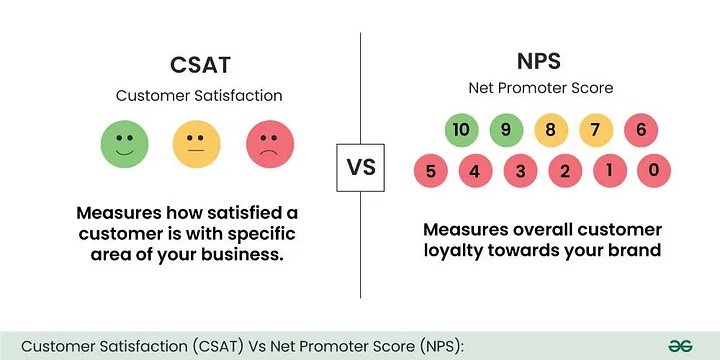Customer Satisfaction Score (CSAT) is one of the simplest, yet most effective ways to measure how satisfied your customers are with your product or service. In this guide, you’ll learn how to calculate CSAT, its benefits and limitations, and best practices for using it alongside other metrics.
What Is CSAT?
CSAT measures how happy users are with a specific interaction or experience, such as a product purchase or a support call. It’s typically collected via short surveys that ask customers to rate their satisfaction on a scale—often 1 to 10.
Example Prompt: “How satisfied are you with our product? Rate it on a scale from 1–10 (1 = Not Satisfied at All, 10 = Extremely Satisfied).”
Those who pick the highest scores (e.g., 7–10) are considered “satisfied.”
How to Calculate CSAT
1. Gather Responses: Collect the total number of survey responses (e.g., 200).
2. Identify High Scores: Count how many gave a top-tier rating (e.g., 160).
3. Use the Formula:

Example: (160 / 200) x 100 = 80%

Benefits of CSAT
1. Simplicity
• Easy to implement and calculate.
• Quick for users to fill out, leading to higher response rates.
2. Real-Time Insights
• Collect user feedback right after they interact with your product or service, capturing immediate impressions.
Limitations of CSAT
1. Subjective
• Influenced by personal factors, moods, or temporary frustrations.
• Unhappy users may skip the survey altogether, skewing results.
2. Not Comprehensive
• Focuses only on satisfaction, not loyalty or brand perception.
3. Short-Term View
• A snapshot of immediate reactions; doesn’t reflect long-term customer relationships.
Remember: A momentary “happy” user might not become a loyal, returning customer.
When to Collect CSAT
• After Customer Support: Right after resolving an issue.
• Post-Delivery (eCommerce): Once a customer receives a product.
• After Milestones: Such as completing a training or a significant service interaction.
Best Practice: Prompt users for feedback within 24–48 hours while the experience is still fresh in their minds.
Tips to Avoid Interrupting Critical Activities
• Don’t show a survey mid-checkout or during a complex task.
• Avoid surveying brand-new users who haven’t fully explored your product (e.g., right after onboarding).
Periodic Surveys
Sending periodic surveys via email is another way to gather CSAT, though response rates may be under 10%. Still, it can provide valuable trends over time.
How to Mitigate CSAT Downsides
1. Combine It With Other Metrics
• NPS (Net Promoter Score): Measures user loyalty and willingness to recommend.
• CES (Customer Effort Score): Captures how easy it is to complete tasks.
• CLV (Customer Lifetime Value): Tracks the total value of a customer over time.
2. Include Open-Ended Questions
• Ask, “What could we improve?” to gather actionable feedback when someone rates you poorly.
3. Focus on Trends, Not One-Off Scores
• Look at patterns over time—do particular user segments or customer journey stages consistently yield lower scores?
• Break down CSAT by demographics or touchpoints for deeper insights.

Final Thoughts on CSAT
CSAT is a valuable tool, but it only tells part of the story. Pairing CSAT with broader metrics and open-ended questions can help you see the bigger picture. By focusing on how satisfied customers are after specific interactions, you can pinpoint areas for quick wins, monitor shifts in user sentiment, and fine-tune your product or service accordingly.
Ready to Boost Your Customer Satisfaction?
Whether you’re looking to optimize your CSAT surveys or integrate them with other essential metrics, Dmazing Studio can guide you. We have over 11 years of experience helping teams improve user experiences through data-driven design and strategy.
Book your FREE 30-minute consultation here:
https://calendly.com/dmazing-studio/30min
We’ll show you how to transform CSAT insights into real product improvements—driving both customer happiness and bottom-line growth.



